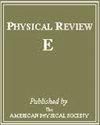各向异性超交换相互作用与弱铁磁性
IF 2.4
3区 物理与天体物理
Q2 PHYSICS, FLUIDS & PLASMAS
引用次数: 4394
摘要
将Anderson超交换理论扩展到包含自旋轨道耦合,建立了各向异性超交换相互作用理论。推导了Dzialoshinski在纯对称基础上提出的反对称自旋耦合和对称伪偶极相互作用。估计它们的数量级分别为($\frac{\ensuremath{\Delta}g}{g}$)和${(\frac{\ensuremath{\Delta}g}{g})}^{2}$倍于各向同性超交换能。还讨论了高阶自旋耦合。作为一个反对称自旋耦合的例子,说明了Cu ${\mathrm{Cl}}_{2}$\ifmmode\cdot\else\textperiodcentered\fi{} 2 ${\mathrm{H}}_{2}$ O的情况。在Cu ${\mathrm{Cl}}_{2}$\ifmmode\cdot\else\textperiodcentered\fi{} 2 ${\mathrm{H}}_{2}$ O中,提出了一种不同于目前公认的自旋排列。这种反对称相互作用是造成$\ensuremath{\alpha}$ - ${\mathrm{Fe}}_{2}$${\mathrm{O}}_{3}$、MnC ${\mathrm{O}}_{3}$和Cr ${\mathrm{F}}_{3}$中弱铁磁性的原因。随着温度的降低,垂直于三角轴的顺磁化率预计会在nsamel温度附近急剧增加,正如在Cr ${\mathrm{F}}_{3}$中实际观察到的那样。本文章由计算机程序翻译,如有差异,请以英文原文为准。
Anisotropic Superexchange Interaction and Weak Ferromagnetism
A theory of anisotropic superexchange interaction is developed by extending the Anderson theory of superexchange to include spin-orbit coupling. The antisymmetric spin coupling suggested by Dzialoshinski from purely symmetry grounds and the symmetric pseudodipolar interaction are derived. Their orders of magnitudes are estimated to be ($\frac{\ensuremath{\Delta}g}{g}$) and ${(\frac{\ensuremath{\Delta}g}{g})}^{2}$ times the isotropic superexchange energy, respectively. Higher order spin couplings are also discussed. As an example of antisymmetric spin coupling the case of Cu${\mathrm{Cl}}_{2}$\ifmmode\cdot\else\textperiodcentered\fi{}2${\mathrm{H}}_{2}$O is illustrated. In Cu${\mathrm{Cl}}_{2}$\ifmmode\cdot\else\textperiodcentered\fi{}2${\mathrm{H}}_{2}$O, a spin arrangement which is different from one accepted so far is proposed. This antisymmetric interaction is shown to be responsible for weak ferromagnetism in $\ensuremath{\alpha}$-${\mathrm{Fe}}_{2}$${\mathrm{O}}_{3}$, MnC${\mathrm{O}}_{3}$, and Cr${\mathrm{F}}_{3}$. The paramagnetic susceptibility perpendicular to the trigonal axis is expected to increase very sharply near the N\'eel temperature as the temperature is lowered, as was actually observed in Cr${\mathrm{F}}_{3}$.
求助全文
通过发布文献求助,成功后即可免费获取论文全文。
去求助
来源期刊

Physical Review E
PHYSICS, FLUIDS & PLASMASPHYSICS, MATHEMAT-PHYSICS, MATHEMATICAL
CiteScore
4.50
自引率
16.70%
发文量
2110
期刊介绍:
Physical Review E (PRE), broad and interdisciplinary in scope, focuses on collective phenomena of many-body systems, with statistical physics and nonlinear dynamics as the central themes of the journal. Physical Review E publishes recent developments in biological and soft matter physics including granular materials, colloids, complex fluids, liquid crystals, and polymers. The journal covers fluid dynamics and plasma physics and includes sections on computational and interdisciplinary physics, for example, complex networks.
 求助内容:
求助内容: 应助结果提醒方式:
应助结果提醒方式:


